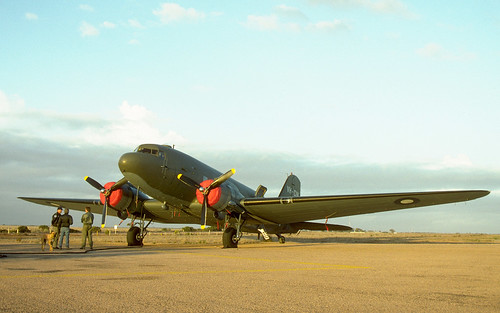
The Douglas DC-3 is one of the most iconic and influential aircraft in aviation history. It was developed by the Douglas Aircraft Company and first flew in 1935. The DC-3 played a pivotal role in transforming both military and commercial aviation, and its design set the standard for modern airliners.
Key Features and Design:
Type: Twin-engine, propeller-driven, all-metal monoplane.
Engines: Two Pratt & Whitney R-1830 Twin Wasp radial engines (though variants had other engines).
Capacity: Typically carried 21 to 32 passengers or 6,000 pounds (2,700 kg) of cargo.
Range: Approximately 1,500 miles (2,414 km), making it suitable for long-haul flights.
Speed: Cruised at around 180 mph (290 km/h), faster than most aircraft of its time.
Structure: It had a distinctive tail-dragger landing gear with a tailwheel and a robust metal structure, making it durable and capable of landing on rough, unpaved airstrips.
Historical Significance:
Commercial Aviation: The DC-3 revolutionized the airline industry by being the first airliner that made passenger air travel profitable without needing government subsidies. Airlines like American Airlines, TWA, and United Airlines adopted it quickly, helping to establish widespread air travel in the U.S. and around the world. It was known for its comfort and reliability, and it set the standard for airliners for decades.
World War II Service: During World War II, the DC-3 was adapted for military use as the C-47 Skytrain (in the U.S.) or Dakota (by British forces). It played a critical role in transporting troops, supplies, and paratroopers. The C-47 was instrumental in major wartime operations, including the D-Day invasion, where thousands of paratroopers were dropped behind enemy lines in DC-3s.
Post-war Influence: After WWII, thousands of surplus DC-3s and C-47s were sold to civilian airlines and cargo carriers. The aircraft continued to serve for decades in commercial aviation, and many are still in use today in cargo, survey, and even passenger services, particularly in remote or less developed areas.
Longevity and Legacy:
The DC-3's combination of durability, ease of maintenance, and excellent performance made it one of the longest-serving aircraft in aviation history. More than 16,000 DC-3s and its military variants were built, and many are still flying today in various roles.
Versatility: Its rugged construction allowed it to operate in a variety of conditions, from Arctic cold to tropical heat, and from paved runways to rough, dirt airstrips.
Cultural Impact: The DC-3 is often hailed as the plane that "changed the world" because of its role in both peacetime and war. Aviation enthusiasts regard it as a classic, and it is often displayed in museums or flown at air shows as a symbol of the Golden Age of aviation.
Variants:
- DC-3A: An improved version with more powerful 1,000–1,200 hp (750–890 kW) Pratt & Whitney R-1830 Twin Wasp engines
- C-47 Skytrain/Dakota: Military transport version, used extensively during WWII.
- DC-3C: Post-war conversion of military aircraft back to civilian use.
- Super DC-3: A post-war upgraded version with a redesigned wing and tail, along with more powerful engines, though it wasn't as successful commercially.
- C-53 Skytrooper was a military transport variant built specifically for carrying troops and was not intended for cargo operations.
Fun Facts:
The DC-3 was the first aircraft capable of flying long distances and on major routes without needing government subsidies, which was crucial for the expansion of airlines.
Over 400 DC-3s are still airworthy today, more than 80 years after the aircraft's introduction.
It was designed in response to a request by American Airlines' CEO, who wanted a sleeper aircraft for long-distance flights. The result was the DC-3, though most of its versions were designed for standard passenger seating.
The Douglas DC-3 remains a symbol of early commercial aviation and a testament to engineering that has stood the test of time.









No comments:
Post a Comment